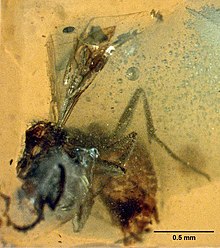Haidomyrmodes
|
Haidomyrmodes Temporal range: Late Albian and Early Cenomanian |
|
|---|---|
 |
|
| Haidomyrmodes mammuthus holotype gyne | |
| Scientific classification | |
| Kingdom: | Animalia |
| Phylum: | Arthropoda |
| Class: | Insecta |
| Order: | Hymenoptera |
| Family: | Formicidae |
| Subfamily: | †Sphecomyrminae |
| Genus: | †Haidomyrmodes |
| Species: | †H. mammuthus |
| Binomial name | |
|
Haidomyrmodes mammuthus Perrichot et al, 2008 |
|
Haidomyrmodes is an extinct genus of ant in the formicid subfamily Sphecomyrminae, and is one of only three genera placed in the tribe Haidomyrmecini. The genus contains a single described species, Haidomyrmodes mammuthus. Haidomyrmodes is known from several Middle Cretaceous fossils which have been found in Europe.
Haidomyrmodes is known from a group of three fossils, the holotype, specimen number "MNHN ARC 50.2", and the paratypes "MNHN ARC 242" and "MNHN AIX 1.2". All three specimens are housed in the fossil collections of the Department of Earth History, Muséum national d'histoire naturelle, Paris, France. The holotype specimen is composed of a mostly complete winged adult female, while the paratypes are both of incomplete worker caste members. All of the specimens are preserved as inclusions in transparent chunks of Late Albian to Early Cenomanian Charentese amber found in the Charente-Maritime area of France.
The fossil was first studied by a team of paleoentomologists led by Vincent Perrichot of the Humboldt University of Berlin. The team's 2008 type description of the new genus and species was published in the journal Naturwissenschaften. The genus name Haidomyrmodes was coined by Perrichot et al as a combination of Haidomyrmex, the type genus for Haidomyrmecini, and the suffix -odes meaning "with the form of". The specific epithet mammuthus is a reference to the resemblance between the species' mandibles and the tusks of a mammoth. Along with Haidomyrmex and Haidoterminus Haidomyrmodes is one of only three genera in Haidomyrmecini.
...
Wikipedia
